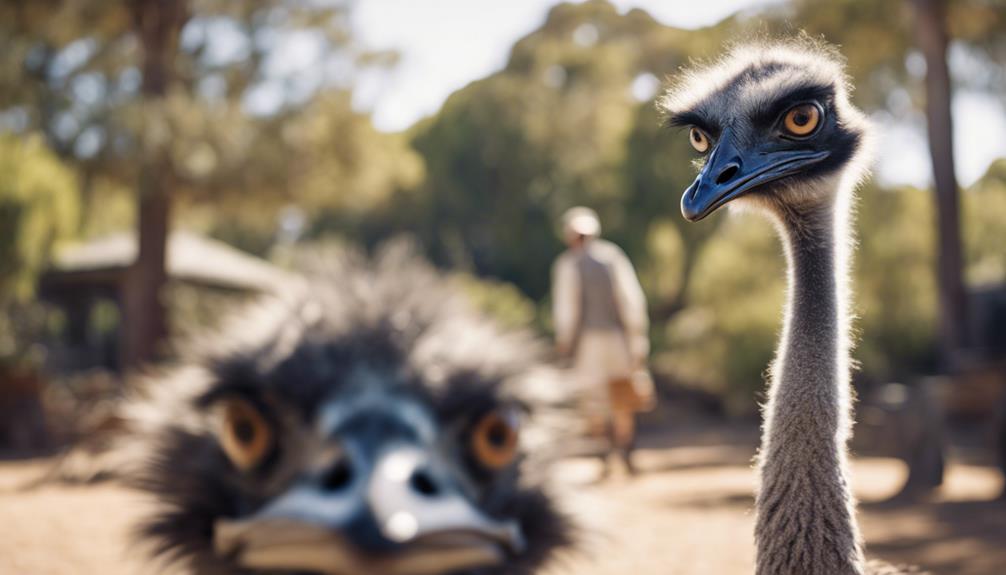Are you intrigued by the remarkable flightless emu, Australia’s unique bird?
With its distinctive appearance and fascinating behavior, the emu is a true marvel of nature. Standing up to 2 meters tall and weighing up to 45 kilograms, these large birds are second in size only to the ostrich.
Emus have adapted to survive in a variety of habitats, although they avoid heavily populated areas, arid land, and dense forests. Their omnivorous diet includes grasses, fruits, berries, seeds, plants, and insects.
You’ll be captivated by their vocalizations, which range from loud booming to grunting sounds. Emus typically travel in pairs or form large flocks, following a seasonal migration pattern.
While not endangered overall, some isolated populations are at risk due to habitat loss and vehicle collisions.
Join us as we explore the physical characteristics, habitat, behavior, and conservation status of these incredible birds.
Key Takeaways
- Emus are the second largest bird in the world, after the ostrich.
- Emus have specialized pelvic limb musculature and gastrocnemius muscles in their lower legs.
- Male emus experience hormone changes and incubate the eggs.
- Emus are farmed for their oil, leather, and meat.
Physical Characteristics
You can easily identify emus by their long, lower profile, three-toed feet, and soft, brown feathers. Emu feathers are long and provide excellent insulation, helping to regulate their body temperature. These feathers have the ability to absorb energy from the sun, protecting their skin from the heat.
Emus have an omnivorous diet, consuming a variety of foods such as grasses, flowers, fruit, berries, seeds, plants, and insects. They also require stones and pebbles in their diet to aid in digestion. It’s important to note that emus shouldn’t be fed by humans, as their natural diet is best for their health and safety.
By understanding the physical characteristics and diet of emus, you can appreciate and respect these fascinating flightless birds in their natural habitat.
Habitat and Behavior
Explore the diverse habitats and intriguing behaviors of these remarkable creatures.
Emus are well adapted to survive in a variety of habitats in Australia and New Guinea, excluding heavily populated areas, arid land, and dense forests. They can be found in grasslands, savannas, shrublands, and coastal areas.
Emus follow a seasonal migration pattern, moving in search of abundant feeding areas. Their migration is usually on foot, as they’re unable to fly.
Emus are vocal birds, making loud booming, grunting, and drumming sounds. These vocalizations serve various purposes, including communication between individuals and warning signals. The male emu’s booming call is particularly impressive, and it can be heard from a distance.
These behaviors and adaptations allow emus to thrive in their unique environments, making them truly fascinating creatures to observe.
Conservation Status
The conservation status of emus isn’t listed as endangered overall, although some isolated populations are at risk due to collisions with vehicles and habitat loss. The impact of human activity has been a significant factor in the decline of these populations.
As emus migrate on foot to find abundant feeding areas, they often encounter roads and highways, leading to increased chances of vehicle collisions. Additionally, human development has resulted in the destruction and fragmentation of their natural habitats, limiting their ability to find suitable food and breeding grounds.
It’s crucial for conservation efforts to focus on mitigating these threats to ensure the long-term survival of these magnificent flightless birds. By implementing measures such as wildlife corridors and awareness campaigns to reduce vehicle collisions, we can help protect the endangered populations and ensure the continued existence of this unique species.
Frequently Asked Questions
How long does it take for emu eggs to hatch?
Emu eggs take around 8 weeks to hatch. During this period, the male emu incubates the eggs. He turns them around 10 times a day. This behavior is a part of emu breeding behavior.
Do emus have any natural predators?
Emus have natural predators such as dingoes, foxes, and wedge-tailed eagles. They rely on their speed and agility to escape from these threats. When breeding, emus form pairs and the male guards the eggs from potential predators.
How far can emus migrate during their seasonal migration?
Emus can migrate up to 1,000 kilometers during their seasonal migration. Their migration patterns are influenced by factors such as food availability, climate, and the need to find suitable breeding grounds.
Can emus fly at all, even though they are classified as flightless birds?
Emus are classified as flightless birds because they lack the necessary adaptations for sustained flight. Their large size, heavy body, and underdeveloped wings make it impossible for them to generate enough lift and stay airborne. Emus’ flight abilities are limited to short bursts of running and jumping.
Are emus social animals that live in groups, or do they prefer to be solitary?
Emus are social animals that live in groups, known as flocks. They typically travel in pairs or form large flocks during migration. However, during the breeding season, mating pairs form and the male emu takes on the role of incubating and caring for the eggs.
Conclusion
In conclusion, the emu is a fascinating and unique bird found in Australia and New Guinea. It stands out among other flightless birds with its distinctive appearance and large size.
Emus have adapted to survive in various habitats and have an omnivorous diet. They are known for their vocalizations and their seasonal migration patterns.
While emus are not endangered overall, some isolated populations face threats due to habitat loss and vehicle collisions. Emus are also commercially farmed for their oil, leather, and meat.


